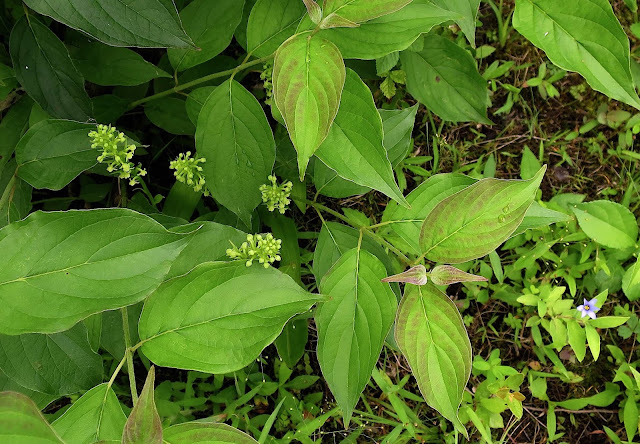I've been paddling this stretch of the Hudson River at Moreau for nearly 25 years, noting every flower that grows along these forested banks. So very few surprises await me when I launch my canoe onto these beautiful waters each year. Or so I used to think. Just a year ago, I WAS surprised, when I found a new patch of Tubercled Orchids (Platanthera flava) thriving on the grassy verge of an island just off the boat launch site. When I set off to revisit the site yesterday, I wondered: Are those orchids still thriving there?
Oh boy, ARE they! At least twice as many stems as I found last year!
This orchid gets its common name from the little bump, called a tubercle, that protrudes from its lower lip. Here's a close-up look at this orchid's floret, showing that tubercle.
Not only was that original patch on the grassy bank at least twice the size as it was last year, I also found some new specimens growing in a nearby, but disjunct area under a Silky Dogwood shrub.
This little island is also home to many other flowering plants, including the pretty little Blue-eyed Grass (Sisyrinchium montanum). I see the remains of a dragonfly nymph among them.
Yellow Loosestrife (Lysimachia terrestris) also thrives here, finding its place among the alders and huckleberries. This flower is also called Swamp Candles, for its clusters of bright-yellow blooms that light up the shadows beneath the trees.
Sweet little Bluets (Houstonia caerulea) gather in clusters along the banks.
Bluets and Sundrops together spangle the grassy open areas.
Here's a closer view of those Small Sundrops (Oenothera perennis), along with its visiting tiny bee.
More bright-yellow flowers will grow in teeming masses on this island, once the Pale St. Johnsworts (Hypericum ellipticum) open their dark-orange buds.
The dominant shrubbery that almost completely covers these islands is Silky Dogwood, but a second shrub manages to find a niche here as well. Both the dogwood and this Elderberry (Sambucus nigra ssp. canadensis) bear clusters of small white flowers, but the Elderberry's clusters are bigger and flatter.
In late May, these islands are dotted with the bright-pink, extravagantly fragrant flowers of Early Azalea (Rhododendron prinophyllum), the shrubs now long past blooming but still recognizable by their whorled leaves. Later next month, there will be both Black Huckleberries and Lowbush Blueberries ripe for the picking.
Because these little river islands are frequently inundated as the river rises and falls, many wetland-loving sedges thrive along the shores. I don't know many sedges by name, but that doesn't mean I don't delight in their beauty. This sedge grows wands that are decorated with golden stars.
Here's one with a sturdier stem that is topped with spiky yellow inflorescences.
This one I do know: Tussock Sedge, which looks like an exploding fountain of graceful grass.
Update: Wow! It's a good thing I went to explore my orchid island the day I did! I passed by this stretch of the Hudson River below the Spier Falls Dam just a day later, to find that someone had pulled the plug!
The water level is now so low, I never would have been able to reach the shore where those Tubercled Orchids grow. (What looks like hard sand in these photos is really knee-deep mud.) They must be working on the next dam downstream (Sherman Island Dam), requiring a lower water level. If the water stays low for more than a few days, it will be interesting to see the flowers that will spring into bloom.


















6 comments:
Hi Jacqueline, What a lovely trip on the river. There are so many little flowers growing everywhere if we only look. I love the blue-eyed grass and bluets and I'm always surprised at the number of orchids growing in the northeast. There were quite a few white bluets growing in my neighbors yard and she let me dig some.....
What a wonderful place to paddle! Lots of interesting species there. Believe it or not, I finally saw (and recognized) Bluets this summer. I think it's so inconspicuous that I just missed it.
Your super-sharp photos tid me over till I get a chance to paddle/botanize at Spier. Can I venture a guess on the sedges? Do you think the first could be Carex intumescens and the second Carex stipata? Grasses (and sedges) are the neglected step-children of the botanical family. They need our love.
Thanks, friends, for stopping by to leave your most welcome comments. It makes me so very happy to think that you like to come along on my hikes and paddles and that you take delight in the wonders that I find. I started my blog in the hopes that I might show folks the beautiful and amazing things that reside right here among and around us, and your encouraging comments sure do confirm me. I am so grateful for them. I am also grateful for wash wild's sedge guesses. Although my own ignorance prevents me from confirming or questioning his guesses, I agree that this is a botanical group that deserves more attention. The shapes and colors are every bit as fascinating as those of wildflowers.
Beautiful location and beautiful photos. You're fortunate to have those botanical bonanzas so close by.
This type of pictures can be best capture by Canon Powershot
Post a Comment